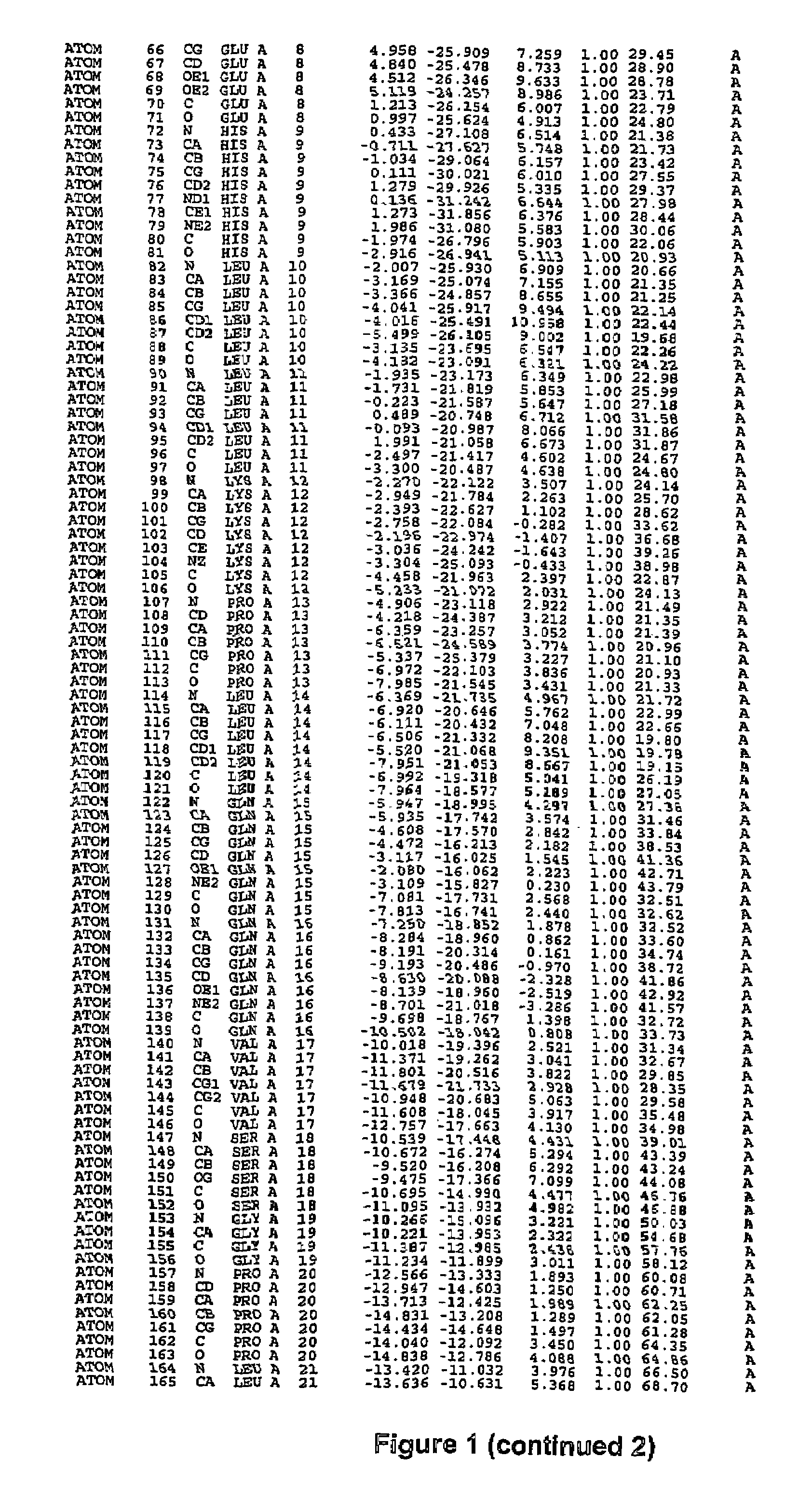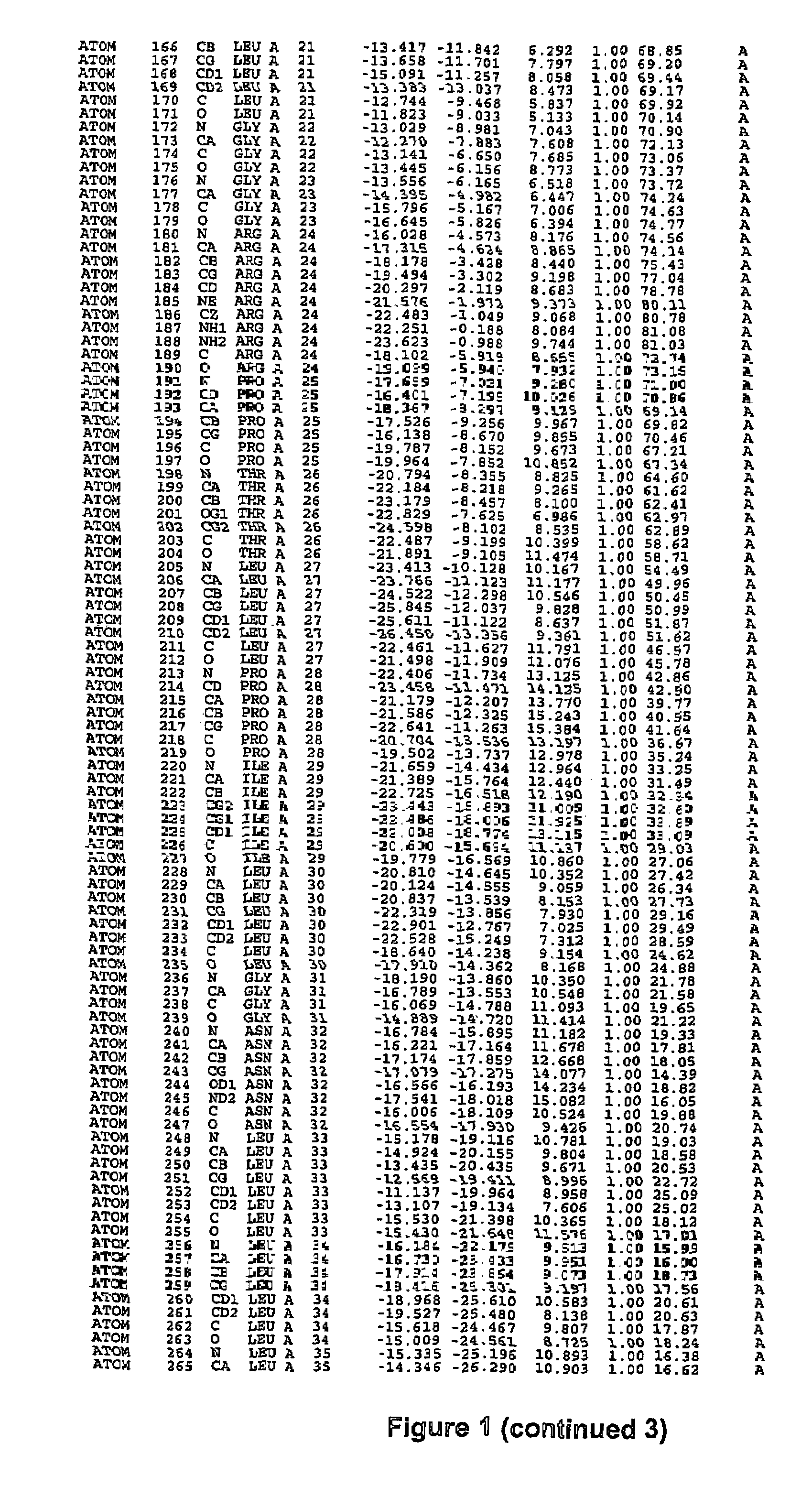Protein crystal comprising the processivity clamp factor of DNA polymerase and a ligand, and its uses
a technology of processivity clamp factor and dna polymerase, applied in the field of protein crystal, can solve the problems of dramatic consequences on cell survival, severe impairing of replication,
- Summary
- Abstract
- Description
- Claims
- Application Information
AI Technical Summary
Benefits of technology
Problems solved by technology
Method used
Image
Examples
example 1
Crystallographic Study of the Escherichia coli β Sliding Clamp Complexed with the β Binding Peptide of Pol IV DNA Polymerase of E. coli.
1. β Binding Peptide Synthesis and Purification
[0098]The 16-mer peptide sequence VTLLDPQMERQLVLGL (P16) (SEQ ID NO: 1), representing the 16 last residues of Pol IV DNA polymerase of E. coli, was obtained purified from Neosystem (Illkirch, France) and the 22-mer control peptide. RPVKVTPNGAEDESAEAFPLEF (CLIP) (SEQ ID NO: 2) was a gift from Dr J. P. Briand (Strasbourg, France). P16 was resuspended at 1.1 mg / ml in a buffer containing Tris HCl 20 mM, pH 7.5, 5 mM EDTA, 20% glycerol, and kept at −80° C. CLIP was resuspended in 20 mM NaHCO3 buffer, pH 9, at concentrations of 250, 100 and 10 pmoles / μl
2. β Protein Purification
[0099]The dnaN gene encoding E. coli β sliding clamp (hereafter referred to as β protein) was cloned into the pET15b plasmid (Invitrogen). The β protein was expressed in a transformed E. coli BL21(DE3)pLysS / (pET15b-dnaN) and was purifi...
example 2
In vitro Study of the β Clamp-β Binding Peptide of Pol IV Interaction by Competition Assays
[0111]In order to ascertain the biological relevance of the P16 peptide-β clamp interaction observed in the crystallographic structure, an in vitro assay based on the activity of Pol IV DNA polymerase was designed. This assay relies on the observation that the in vitro activity of Pol IV is greatly enhanced by the presence of the β subunit loaded onto a primer / template DNA substrate (Wagner et al., 2000) (FIG. 3A, compare lanes 1 and 5 or 9 and 13), while the enzyme alone incorporates nucleotides in a distributive mode (Wagner et al, 1999).
[0112]Briefly, P16 peptide and a control peptide (CLIP) were diluted in 20 mM NaHCO3 at concentrations of 250, 100 and 10 pmol / μl. 5′ end radiolabelling, purification and annealing of synthetic primers were performed as previously described (Wagner et al., 1999). The 30 / 90 nucleotide synthetic construct (Wagner et al., 2000) was obtained by annealing the 30 ...
example 3
In vivo Study of the Inhibition of Bacterial Growth by the β Binding Peptide of Pol IV
[0116]Plasmids bearing either the wild type Pol IV (pWp4) or the Pol IV mutant deleted for the 5 last C-terminal residues (pD5p4) coding sequences under the IPTG inducible lac promoter were transformed into recipient E. coli cells (BL21(DE3, pLys)). These transformed cells were then allowed to grow in LB medium at 37° C. with aeration and without or with (FIG. 4) addition of the protein expression inducer IPTG (0.1 mM). Growth rates were monitored by measuring the optical density of the cultures (OD 600 nm) at different time points.
[0117]The growth rates of both cultures without artificial protein expression were identical whether the cells contain the wild type Pol IV expression plasmid (pWp4) or the Pol IVD5 mutant (pD5p4). On the other hand, when protein expression was induced by the adjunction of low IPTG concentration in the culture medium (FIG. 4), a clear growth inhibition was observed for t...
PUM
| Property | Measurement | Unit |
|---|---|---|
| Molar density | aaaaa | aaaaa |
| Molar density | aaaaa | aaaaa |
| Molar density | aaaaa | aaaaa |
Abstract
Description
Claims
Application Information
 Login to View More
Login to View More - R&D
- Intellectual Property
- Life Sciences
- Materials
- Tech Scout
- Unparalleled Data Quality
- Higher Quality Content
- 60% Fewer Hallucinations
Browse by: Latest US Patents, China's latest patents, Technical Efficacy Thesaurus, Application Domain, Technology Topic, Popular Technical Reports.
© 2025 PatSnap. All rights reserved.Legal|Privacy policy|Modern Slavery Act Transparency Statement|Sitemap|About US| Contact US: help@patsnap.com



